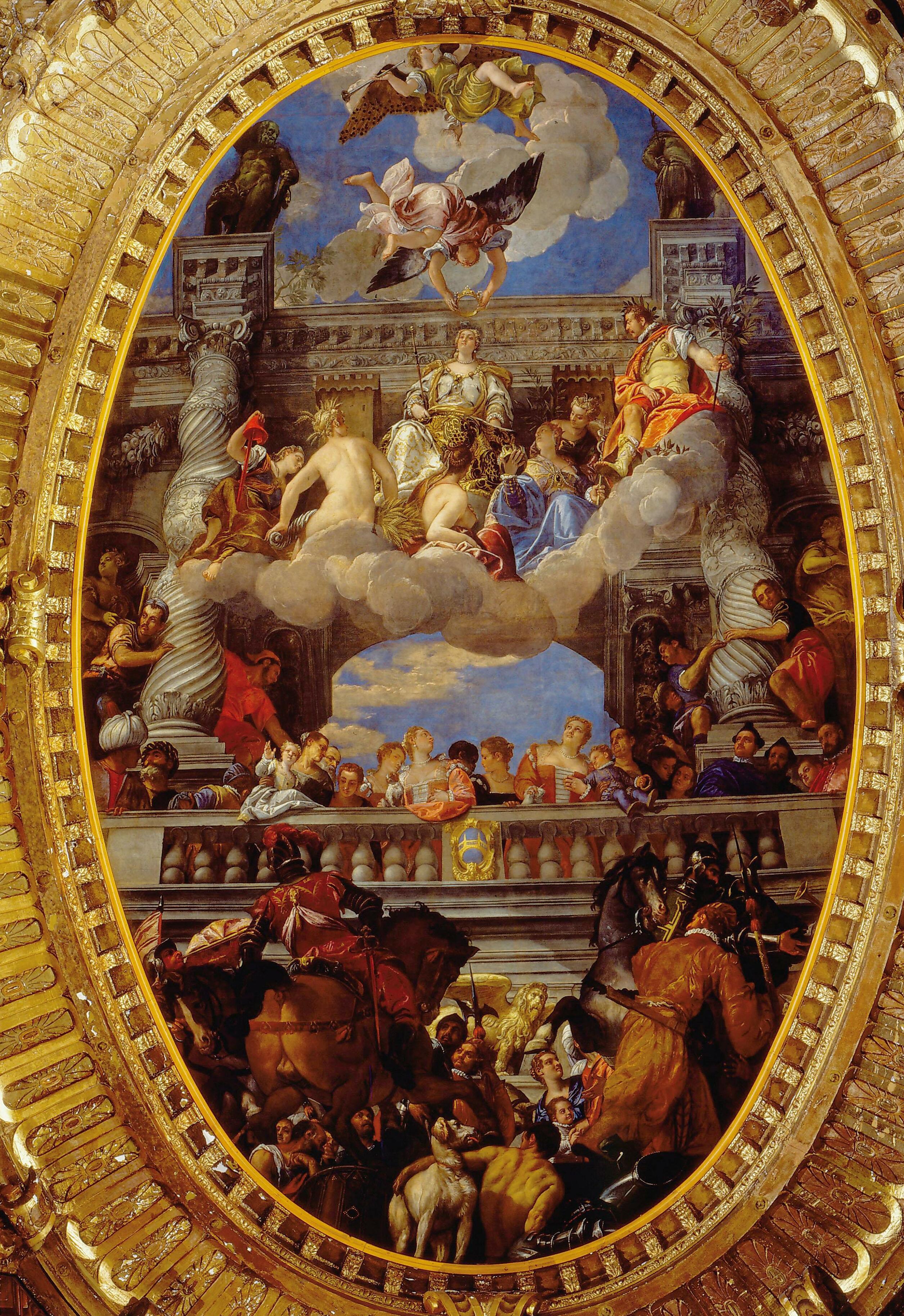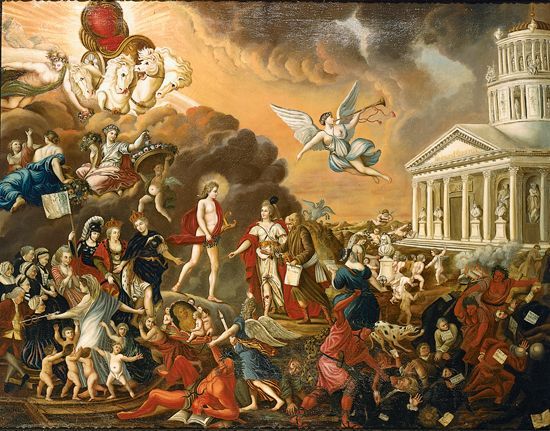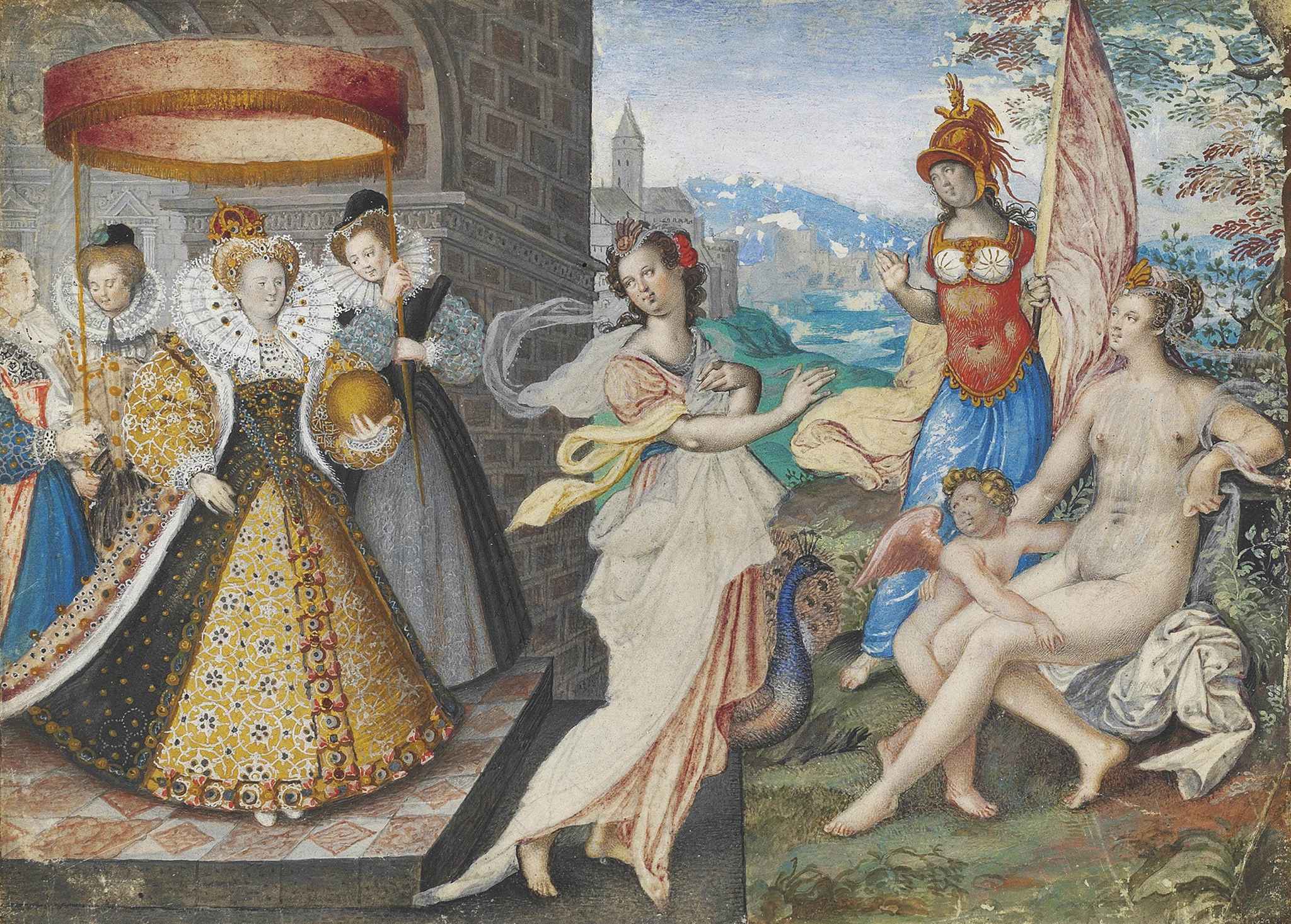|
Apotheosis
Apotheosis (, ), also called divinization or deification (), is the glorification of a subject to divine levels and, commonly, the treatment of a human being, any other living thing, or an abstract idea in the likeness of a deity. The original sense of apotheosis relates to religion and is the subject of many works of art. Figuratively "apotheosis" may be used in almost any context for "the deification, glorification, or exaltation of a principle, practice, etc.", so normally attached to an abstraction of some sort. In religion, apotheosis was a feature of many religions in the ancient world, and some that are active today. It requires a belief that there is a possibility of newly created gods, so a polytheistic belief system. The major modern religions of Christianity, Islam, and Judaism do not allow for this, though many recognise minor sacred categories such as saints (created by a process called canonization). In Christian theology there is a concept of the faithful bec ... [...More Info...] [...Related Items...] OR: [Wikipedia] [Google] [Baidu] |
The Apotheosis Of Washington
''The Apotheosis of Washington'' is the fresco painted by Greek- Italian artist Constantino Brumidi in 1865 and visible through the oculus of the dome in the rotunda of the United States Capitol Building in Washington, D.C. The fresco is suspended above the rotunda floor and covers an area of . The figures painted are up to tall and are visible from the floor below. The dome was completed in 1863, and Brumidi painted it over the course of eleven months at the end of the American Civil War. He was paid $40,000 ($ in today's funds) for the fresco. Brumidi had worked for three years in the Vatican under Pope Gregory XVI, and served several aristocrats as an artist for palaces and villas, including the prince Torlonia. He immigrated to the United States in 1852, and spent much of the last 25 years of his life working in the Capitol. In addition to ''The Apotheosis of Washington'', Brumidi designed the Brumidi Corridors, ornately decorated corridors on the first floor o ... [...More Info...] [...Related Items...] OR: [Wikipedia] [Google] [Baidu] |
The Apotheosis Of Voltaire
''The Apotheosis of Voltaire led by Truth and crowned by Glory'' (”), also known as “The Triumph of Voltaire” () is a 1775 oil painting by Alexandre Duplessis. A different painting by Robert-Guillaume Dardel in the Musée Carnavalet is also often known by this title. Both compositions were reproduced as prints, probably around the time that Voltaire's remains were transferred to the Paris Pantheon with great ceremony and huge crowds in 1791. Apotheosis compositions had been popular in Western art since the Late Renaissance, celebrating both religious and secular figures, based on classical precedents. The term means the process of "becoming a god", though by the Baroque this was not intended literally. Nonetheless, there was a certain irony in painting such a subject to honour the famous sceptic Voltaire. Description In the centre of Duplessis's painting, Melpomene muse of tragedy, leads Voltaire towards Apollo while behind the god, a putto holds up a waiting crown o ... [...More Info...] [...Related Items...] OR: [Wikipedia] [Google] [Baidu] |
United States Capitol Building
The United States Capitol, often called the Capitol or the Capitol Building, is the seat of the United States Congress, the legislative branch of the federal government. It is located on Capitol Hill at the eastern end of the National Mall in Washington, D.C. Although no longer at the geographic center of the national capital, the U.S. Capitol forms the origin point for the street-numbering system of the district as well as its four quadrants. Like the principal buildings of the executive and judicial branches, the Capitol is built in a neoclassical style and has a white exterior. Central sections of the present building were completed in 1800. These were partly destroyed in the 1814 Burning of Washington, then were fully restored within five years. The building was enlarged in the 1850s by extending the wings for the chambers for the bicameral legislature, the House of Representatives in the south wing and the Senate in the north wing. The massive dome was completed aroun ... [...More Info...] [...Related Items...] OR: [Wikipedia] [Google] [Baidu] |
Imhotep
Imhotep (; "(the one who) comes in peace"; ) was an Egyptian chancellor to the King Djoser, possible architect of Djoser's step pyramid, and high priest of the sun god Ra at Heliopolis. Very little is known of Imhotep as a historical figure, but in the 3,000 years following his death, he was gradually glorified and deified. Traditions from long after Imhotep's death treated him as a great author of wisdom texts and especially as a physician. No text from his lifetime mentions these capacities and no text mentions his name in the first 1,200 years following his death. Apart from the three short contemporary inscriptions that establish him as chancellor to the Pharaoh, the first text to refer to Imhotep dates to the time of Amenhotep III (). It is addressed to the owner of a tomb and reads: It appears that this libation to Imhotep was done regularly, as they are attested on papyri associated with statues of Imhotep until the Late Period (). Wildung (1977) expla ... [...More Info...] [...Related Items...] OR: [Wikipedia] [Google] [Baidu] |
Polytheistic
Polytheism is the belief in or worship of more than one Deity, god. According to Oxford Reference, it is not easy to count gods, and so not always obvious whether an apparently polytheistic religion, such as Chinese folk religions, is really so, or whether the apparent different objects of worship are to be thought of as manifestations of a singular divinity. Polytheistic belief is usually assembled into a pantheon (religion), pantheon of Gender of God, gods and goddesses, along with their own religious sects and rituals. Polytheism is a type of theism. Within theism, it contrasts with monotheism, the belief in a God, singular god who is, in most cases, transcendence (religion), transcendent. In religions that accept polytheism, the different gods and goddesses may be representations of forces of nature or ancestral worship, ancestral principles; they can be viewed either as autonomous or as aspects or emanationism, emanations of a creator deity or transcendence (religion), transc ... [...More Info...] [...Related Items...] OR: [Wikipedia] [Google] [Baidu] |
Deity
A deity or god is a supernatural being considered to be sacred and worthy of worship due to having authority over some aspect of the universe and/or life. The ''Oxford Dictionary of English'' defines ''deity'' as a God (male deity), god or goddess, or anything revered as divine. C. Scott Littleton defines a deity as "a being with powers greater than those of ordinary humans, but who interacts with humans, positively or negatively, in ways that carry humans to new Higher consciousness, levels of consciousness, beyond the grounded preoccupations of ordinary life". Religions can be categorized by how many deities they worship. Monotheism, Monotheistic religions accept only one deity (predominantly referred to as "God"), whereas Polytheism, polytheistic religions accept multiple deities. Henotheism, Henotheistic religions accept one God, supreme deity without denying other deities, considering them as aspects of the same divine principle. Nontheistic religions deny any supreme eter ... [...More Info...] [...Related Items...] OR: [Wikipedia] [Google] [Baidu] |
Imperial Cult
An imperial cult is a form of state religion in which an emperor or a dynasty of emperors (or rulers of another title) are worshipped as demigods or deities. "Cult (religious practice), Cult" here is used to mean "worship", not in the modern pejorative sense. The cult may be one of cult of personality, personality in the case of a newly arisen Euhemerus figure, or one of national identity (e.g., Ancient Egyptian Pharaoh or Empire of Japan) or supranational identity in the case of a multinational state (e.g., History of China#Imperial China, Imperial China, Roman Empire). A ''divine king'' is a monarch who is held in a special religious significance by his subjects, and serves as both head of state and a deity or head religious figure. This system of government combines theocracy with an absolute monarchy. Historical imperial cults Ancient Egypt file:Pharaoh.svg, 200px, Ancient Egyptian pharaohs were worshipped as god-kings. The Ancient Egyptian pharaohs were, throughout ancient ... [...More Info...] [...Related Items...] OR: [Wikipedia] [Google] [Baidu] |
Divine Embodiment
A divine embodiment or godform refers to the visualized appearance of the deity assumed in theurgical, Tantra, tantric, and other mystical practices. This process of ritual embodiment is aimed at transforming the practitioner, aligning them with divine powers for spiritual ascent or transformation. The concept is found across diverse traditions, including Western esotericism, Eastern spirituality, and mysticism, where it serves as a method for achieving personal Enlightenment in Buddhism, enlightenment, henosis, union with the divine, or other spiritual goals. In Western esotericism, divine embodiment is most commonly associated with theurgy, particularly in the works of Neoplatonism, Neoplatonists like Iamblichus, where the practitioner assumes a divine form through ritual or meditation to transcend the material world and reach higher spiritual realms. This concept was influenced by ancient Greek practices of invoking gods and embodying divine forces, seen in both the astral ... [...More Info...] [...Related Items...] OR: [Wikipedia] [Google] [Baidu] |
Theosis (Eastern Christian Theology)
''Theosis'' (), or deification (deification may also refer to '' apotheosis'', lit. "making divine"), is a transformative process whose aim is likeness to or union with God, as taught by the Eastern Catholic Churches and the Eastern Orthodox Church; the same concept is also found in the Latin Church of the Catholic Church, where it is termed " divinization". As a process of transformation, ''theosis'' is brought about by the effects of '' catharsis'' (purification of mind and body) and ''theoria'' ('illumination' with the 'vision' of God). According to Eastern Christian teachings, ''theosis'' is very much the purpose of human life. It is considered achievable only through synergy (or cooperation) of human activity and God's uncreated energies (or operations). According to Metropolitan Hierotheos (Vlachos), the primacy of ''theosis'' in Eastern Orthodox Christian theology is directly related to the fact that Byzantine theology (as historically conceived by its principal exp ... [...More Info...] [...Related Items...] OR: [Wikipedia] [Google] [Baidu] |
Ancient Egyptian Deities
Ancient Egyptian deities are the gods and goddesses worshipped in ancient Egypt. The beliefs and rituals surrounding these gods formed the core of ancient Egyptian religion, which emerged sometime in prehistory. Deities represented natural forces and phenomena, and the Egyptians supported and appeased them through offerings and rituals so that these forces would continue to function according to '' maat'', or divine order. After the founding of the Egyptian state around 3100 BC, the authority to perform these tasks was controlled by the pharaoh, who claimed to be the gods' representative and managed the temples where the rituals were carried out. The gods' complex characteristics were expressed in myths and in intricate relationships between deities: family ties, loose groups and hierarchies, and combinations of separate gods into one. Deities' diverse appearances in art of ancient Egypt, art—as animals, humans, objects, and combinations of different forms—also all ... [...More Info...] [...Related Items...] OR: [Wikipedia] [Google] [Baidu] |
Horus
Horus (), also known as Heru, Har, Her, or Hor () in Egyptian language, Ancient Egyptian, is one of the most significant ancient Egyptian deities who served many functions, most notably as the god of kingship, healing, protection, the sun, and the sky. He was worshipped from at least the late prehistoric Egypt until the Ptolemaic Kingdom and Egypt (Roman province), Roman Egypt. Different forms of Horus are recorded in history, and these are treated as distinct gods by Egyptology, Egyptologists."The Oxford Guide: Essential Guide to Egyptian Mythology", Edited by Donald B. Redford, Horus: by Edmund S. Meltzer, pp. 164–168, Berkley, 2003, . These various forms may be different manifestations of the same multi-layered deity in which certain attributes or Syncretism, syncretic relationships are emphasized, not necessarily in opposition but complementary to one another, consistent with how the Ancient Egyptians viewed the multiple facets of reality. He was most often depicted as ... [...More Info...] [...Related Items...] OR: [Wikipedia] [Google] [Baidu] |
Osiris
Osiris (, from Egyptian ''wikt:wsjr, wsjr'') was the ancient Egyptian deities, god of fertility, agriculture, the Ancient Egyptian religion#Afterlife, afterlife, the dead, resurrection, life, and vegetation in ancient Egyptian religion. He was classically depicted as a green-skinned deity with a Pharaoh, pharaoh's beard, partially mummy-wrapped at the legs, wearing a distinctive atef crown and holding a symbolic crook and flail. He was one of the first to be associated with the mummy wrap. When his brother Set (deity), Set cut him to pieces after killing him, with her sister Nephthys, Osiris' sister-wife, Isis, searched Egypt to find each part of Osiris. She collected all but one – Osiris’s genitalia. She then wrapped his body up, enabling him to return to life. Osiris was widely worshipped until the decline of ancient Egyptian religion during the Christianization of the Roman Empire, rise of Christianity in the Roman Empire. Osiris was at times considered the eldest son of ... [...More Info...] [...Related Items...] OR: [Wikipedia] [Google] [Baidu] |









